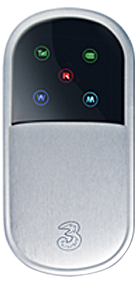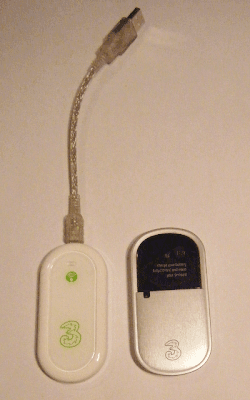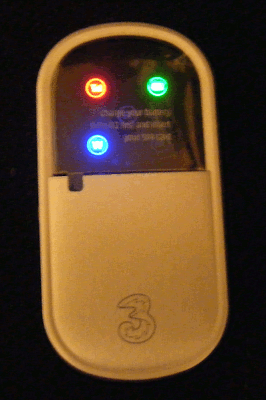 This post is a review with tips about the Mifi, which enables mobile broadband access for your computer, iPod touch or other wifi-enabled device over Three's UK mobile network.
This post is a review with tips about the Mifi, which enables mobile broadband access for your computer, iPod touch or other wifi-enabled device over Three's UK mobile network. What's a Mifi?
What's a MiFi Huawei E5830? (Rhymes with "wifi" rather than "iffy"!)Pictured above, it's a mobile wireless modem that provides a wifi hotspot, i.e. a mobile internet connection that can be shared between more than one device or person. Though of course you can just hog it if you prefer.
Pocketable, light and little bigger than a broadband dongle, you can connect your device to it wirelessly (any kit that has wifi should connect to it), so that your devices can access the internet over 3's mobile network - whether laptop, notebook or netbook (any operating system as long as it has wifi e.g. Windows, Mac, Linux), iPod touch, Playstation or Nintendo DSi.
The idea is that you should be able to use it to get a Net connection anywhere that you can get a 3 mobile signal.
Three are the first UK network to offer something like this.
Mifi trivia (from the 3 team, over dinner!): did you know that when Three were debating what to call their wireless mobile broadband device, suggestions included "iFi" (ultimately deemed to be too much like "iffy") and "Trouser Browser"??
In the box
Mifi, charger, USB cable, a fold out setup guide and a series of guidance cards (good: you can keep the card with the password on it in your wallet; bad: easy to lose, hopefully 3 will work out a way to keep the cards together for the next version. Some of us would also like to see the full specs in the printed documentation for reference, even on just 1 page or 1 card).
The SIM pack is separate. Random tip - the SIM card is tucked inside the "lid" lift up flap, not inside the body of the cardboard wallet. Took me a while to find it at first, I admit.
Uses
It's great when you're out and about and you need a Net connection to browse, deal with email or documents in the cloud etc, and you don't have wifi otherwise - e.g. at a meeting outside your offices or home, or on a train or bus (worked for me on a bus in Central London. Not the Tube, obviously). Much less fiddly than a dongle as you can just keep it in a pocket, briefcase or bag.
It's probably more secure than an internet cafe or public wifi (as long as you use WPA, which you should instead of WEP anyway whenever you use wifi - see below), though it's still best to use https web addresses as much as you can when logging in to Web services.
The sharing feature is cool, e.g. kids in the car can surf etc at the same time whether with netbook, iPod Touch or games console, while several colleagues can use one internet connection at the same time on their own computers.
Or if you sometimes go to stay with relatives or friends who don't have broadband or even an internet connection, then obviously the Mifi can be very handy (as long as there's Three coverage there, of course).
Some features to note
Security - the wifi is encrypted by default, so only people with whom you share your password (e.g. colleagues) should be able to access your Mifi's network. There's a card in the pack with your password, which is unique to each unit. As usual with wifi, you start up your device, look for wireless networks, find the one for your Mifi (its network name or SSID will be on the card), and enter the given password - use WPA not WEP whenever you can, it's far more secure (see more on WPA vs WEP).
There's no indication in the documentation (and there should be) of:
- Battery life - they say on the website it's up to 5 hours, so probably about 3 or 4 hours max of continuous use in practice; if you don't use it it'll hold its charge OK for a few days. It would help to have this info in the manual or more obvious on the online pages (you can only find it from a popup that doesn't indicate that that's where you find the specs). Best charge it up overnight the day before you plan to use it, if you can, and have the charger with you.
- Range - I've managed to use it with a notebook computer that's about 10 m away from the Mifi, even on another floor, when there was another laptop using the connection. I suspect much depends on the local environment.
When you connect it to the computer via the (supplied) USB cable you can change the password, SSID (the broadcast name of your Mifi's wireless network), send and get SMS texts, etc (the charging structure for texts isn't explained in the pack though). Many of us won't bother to change the network key, as the password is unique to each unit - just keep your card very safe! But I think that as with the cabled dongle this only works with Windows computers, not Mac or Linux.
You get the usual My3 access to check usage, topup etc if you go to the My 3 webpage while using the Mifi.
Specs from the 3 site
- Battery, Li 1500mAh
- Charger (Std. 3-pin UK)
- USB cable (mini plug/standard plug)
- Quick Start Guide
- Keep sake card with predefined SSID and Network key
- Help cards, Safety and warranty leaflet
- No internal memory. Memory card supported, microSD 32GB
- Dimensions: 86 x 46.5 x 10.5mm, Weight: 90g
(Not easy to find the specifications - "mobile detail" is the link, it wasn't prominent or obvious enough for me, personally.)
Comparison with a dongle
Benefits over a standard mobile broadband dongle:
- it's entirely wireless, which beats battling with a dangling dongle - I just keep it in a pocket when using it
- only very slightly bigger than a wired broadband dongle and about the same weight, maybe even lighter
- several devices (and several people) can access the internet over one Mifi at the same time - laptop, notebook computer, netbook like the Eee, iPod touch, Playstation, Nintendo DSi. (I'm not clear how many simultaneously, the man in the shop said 3 or 4 devices, I thought I heard it might be 5, but I can't seem to find the details on the 3 site)
- any device which has wifi can use the Mifi, so there are no problems with drivers for Mac, Linux etc
- speed - about the same speed as a wired dongle i.e. 3G or HSDPA depending on coverage (so they come out equal there), but of course neither will be as fast as home broadband. Way faster than "normal" GPRS data though.
The disadvantages?
- more expensive than a dongle - from the 3 website, currently on Pay as You Go a wired dongle costs £19.99 to buy and £10 for 1GB of data use, whereas a Mifi costs £49.99 for the device and £10 for 1 GB (or £69.99 for Mifi plus 3GB of usage valid for up to 3 months)
- you have to remember to switch it off when you're done else it'll run down without your noticing (in my view the current model hasn't got enough of a "low battery" warning when you're not online), and of course remember to charge it via the mains regularly
- the more the connection is shared, the more it will slow down; the most I tried was 2 computers at once, and didn't notice any difference. But then you can't share a dongle's internet connection at all.
- personally, I have had problems using the Mifi with XP computers. No idea why. Vista and Linux were fine.
On the 3 Consumer Panel & trial
Full disclosure - 3MobileBuzz at the end of 2009 kindly asked me to be involved in trials of the innovative MiFi device via UK network operator Three's new Consumer Panel, on which more below. (They also invited me to the official launch of the Mifi a few months back, which I didn't blog at the time as I wanted to get my hands on a Mifi first.)
3 will be reimbursing me for the costs of the Mifi, but I have to give it back at the end of the trial (probably in a couple of weeks), and I'm not getting any payment or kit for taking part. I just get to test it during the consumer trial period without having ultimately to pay for hardware or usage charges.Also, they treated the panellists to drinks (though I couldn't make it there in time for that) and a tasty dinner to discuss our feedback. Thanks to Three too for permission to use their photo of the Mifi (top - the rest are my own).
The Mifi Consumer Panel is an innovative idea too, and basically involves the triallists mystery shopping and testing the Mifi, then feeding back our thoughts.
We each got different assignments, e.g. mine was to get it on Pay As You Go from a Three store (others were asked to try it on Pay Monthly contract etc).
It was up to us as to where we got the Mifi from (except we weren't allowed to get it online), and the 3 stores and independent stores didn't know that we were mystery shoppers. I opted for the £69.99 PAYG package which included the Mifi and 3GB of usage.
I've tried the Mifi with several computers at the same time, but not with another device as I don't have an iPod touch or games console. Others have, though, and report that it works well e.g. with several iPod touches using it at the same time.It's been very impressive that 3MobileBuzz and Three have been so willing to listen to panel feedback and take on board our thoughts and ideas for improvements, about everything from hardware design to customer manuals and how staff sell it in the shops.
For instance, we all thought there were too many buttons - there should just be one - and hopefully the next model will incorporate that suggestion.
Tips and thoughts if you're thinking of getting a Mifi
As mentioned above, a Mifi is more expensive than a cabled dongle, but very much more convenient - you can just keep it in your pocket, briefcase or bag, and if you have colleagues, friends or family with you they can share your 3 internet connection.
If you like the idea of not having a pesky cable getting in the way (as I do) or you need occasionally to have more than one person or device using the internet connection, it's very well worth getting if you don't mind the £30 extra (you can alternatively get it on contract, see the Three site for details e.g. 1 month contract at £15 a month plus £49.99 for the Mifi).
But much of what I said in relation to the 3 broadband dongle still holds true.
Check your 3 mobile broadband coverage in advance (be sure to tick "Mobile broadband") to see how good the signal is in the key areas where you plan to use it, not just your home or workplace - you'll most likely be using it when you're out!
Buy it online if you can, as that gives you a much longer return period during which you can try it out so you can return it if necessary - Three allow 14 days rather than (if you buy it in a shop) 3 days. We all thought 3 days was too short for this product, and hopefully Three will increase the return period for the Mifi. (If you find after the 3 days that you are having trouble using it where you need it, then, as long as it's not like a year later, it's worth going to talk to Three - they said they'll try to help.)
During the moneyback period, make sure you take the Mifi everywhere that you think you'll use it regularly, and try to see what sort of connection you get, if at all, so that you can return it if it doesn't work out. The point is, you're totally dependent on getting decent 3 coverage. No good 3 signal, no internet on the Mifi.
However, bear in mind that 3 are upgrading their network, notably in the South of England (check your area), so you may have problems in some places. Once the work is finished it should be much improved, but it's just bad luck that (in my case at least) the works have been interfering with my Mifi trial - I now have virtually no Three reception at home. See the red below? Not good :(
There will be further works, intended to be completed by end 2010, so hopefully when it's done and dusted we'll all get better 3 signals - they're adding 3000 more stations, apparently it's the biggest engineering project in Europe currently.
Also, Three told us that they'll be bringing out a new version of the Mifi by summer 2010 which incorporates many of our suggestions for improvement (the current "3 button dance" to turn it on and get it working seems unnecessary and confusing), and should have a better battery life too.
Mifi use tips
- The network password for the device is printed on a handy card. You'll want to carry the card with you (somewhere safe), or memorise the password key. It's supposed to remember the password once entered but sometimes it doesn't and you have to re-enter it, which is a big pain if you need an internet connection and you can't remember your password.
- You might want to carry the charger around with you too, for obvious reasons, as you can still use it while it's plugged into the mains. Remember to charge it up regularly.
- And, I repeat again, use WPA (not WEP) and https web addresses wherever possible (at least Google have now enabled https by default for Gmail).
- No good 3 signal, no internet via Mifi. That should be obvious. It may cut in and out on the motorway or train for instance.
- Red light at the top left of the Mifi means no go. You may be able to connect to the Mifi via wifi, but don't be fooled into thinking you'll get an internet connection. Having said that, I've had times when it's red on the top left but bottom right is light blue (it should be green for go, really, in my view - dark & light blue is too confusing), and got a connection with no problem. Go figure. Bottom line - don't necessarily trust the lights, just try it and see; it may work when you think it won't, and unfortunately vice versa too.


No comments:
Post a Comment